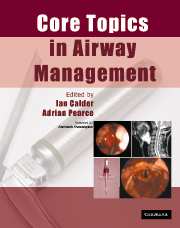Book contents
- Frontmatter
- Contents
- List of contributors
- Preface
- Acknowledgements
- List of abbreviations
- 1 Anatomy
- 2 Physiology of apnoea and hypoxia
- 3 Physics and physiology
- 4 Cleaning and disinfection of airway equipment
- 5 General principles
- 6 Maintenance of the airway during anaesthesia: supra-glottic devices
- 7 Tracheal tubes
- 8 Tracheal intubation of the adult patient
- 9 Confirmation of tracheal intubation
- 10 Extubation
- 11 Light-guided intubation: the trachlight
- 12 Fibreoptic intubation
- 13 Retrograde intubation
- 14 Endobronchial and double-lumen tubes, bronchial blockers
- 15 ‘Difficult airways’: causation and prediction
- 16 The paediatric airway
- 17 Obstructive sleep apnoea and anaesthesia
- 18 The airway in cervical trauma
- 19 The airway in cervical spine disease and surgery
- 20 The aspiration problem
- 21 The lost airway
- 22 Trauma to the airway
- 23 Airway mortality associated with anaesthesia and medico-legal aspects
- 24 ENT and maxillofacial surgery
- 25 Airway management in the ICU
- 26 The airway in obstetrics
- Index
21 - The lost airway
Published online by Cambridge University Press: 15 December 2009
- Frontmatter
- Contents
- List of contributors
- Preface
- Acknowledgements
- List of abbreviations
- 1 Anatomy
- 2 Physiology of apnoea and hypoxia
- 3 Physics and physiology
- 4 Cleaning and disinfection of airway equipment
- 5 General principles
- 6 Maintenance of the airway during anaesthesia: supra-glottic devices
- 7 Tracheal tubes
- 8 Tracheal intubation of the adult patient
- 9 Confirmation of tracheal intubation
- 10 Extubation
- 11 Light-guided intubation: the trachlight
- 12 Fibreoptic intubation
- 13 Retrograde intubation
- 14 Endobronchial and double-lumen tubes, bronchial blockers
- 15 ‘Difficult airways’: causation and prediction
- 16 The paediatric airway
- 17 Obstructive sleep apnoea and anaesthesia
- 18 The airway in cervical trauma
- 19 The airway in cervical spine disease and surgery
- 20 The aspiration problem
- 21 The lost airway
- 22 Trauma to the airway
- 23 Airway mortality associated with anaesthesia and medico-legal aspects
- 24 ENT and maxillofacial surgery
- 25 Airway management in the ICU
- 26 The airway in obstetrics
- Index
Summary
Introduction
A trained anaesthetist rarely has significant difficulty in maintaining a patent airway and ventilating the patient's lungs. When difficulty occurs the degree of difficulty encountered covers a spectrum, at the far end of which is the situation where the patient is consuming oxygen faster than the anaesthetist can deliver it; for the purpose of this chapter this is the definition of the lost airway. Other terms are ‘can't ventilate, can't intubate' (CVCI) or ‘can't intubate, can't oxygenate’ (CICO). This extreme situation is rare in elective general surgery with an incidence of 1 : 10,000 to 1 : 50,000. Diagnosis and management must be complete within minutes of the onset of the problem to have a chance of a successful outcome.
Pathophysiology
An adult patient requires 200–250 ml min–1 of oxygen to sustain life. After induction of anaesthesia if this amount of oxygen cannot be delivered to the patient's lungs they will use up their reserves over 1–2 min (longer if well preoxygenated, sooner in the obese or those with increased requirements) and then they will start to desaturate. Without intervention to increase oxygen delivery to the lungs the patient will die. How long an individual patient will survive will depend on many factors. Anecdotal accounts of death due to airway obstruction (judicial execution by hanging) suggest that about 10 min of complete airway obstruction will result in cardiac arrest.
Most general anaesthetic agents decrease upper airway tone tending to lead to compromise of the natural upper airway and minor degrees of difficulty with facemask ventilation around the time of induction of anaesthesia.
- Type
- Chapter
- Information
- Core Topics in Airway Management , pp. 159 - 168Publisher: Cambridge University PressPrint publication year: 2005
- 1
- Cited by



